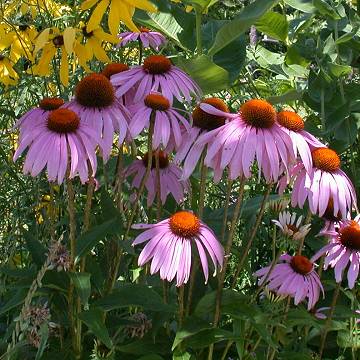

Echinacea purpurea - (image 1 of 4)
Taxonomy
Family: Asteraceae
Habitat
Prairies and open woods.
Associates
Distribution
IL and southern IA to eastern OK, northeast TX and central LA, east irregularly to southern MI, KY, TN, and GA; a few populations occur from VA to NC.
Morphology
Erect perennial to 1.8 m from a fibrous-rooted crown, caudex, or short, stout thizome; stems hirsute to glabrous, simple or with a few branches. Leaf blades broadly lanceolate to ovate, entire to dentate or serrate, less than 5 times longer than wide, parallel-veined. Flowers pink-purple; petals reflexed.
Notes
Flowers mid July to mid August
Wetland indicator: Upland
A popular garden plant and a common component of seed mixtures because it is attractive and easy to grow. Echinacea is commonly thought to be useful for treating or preventing the common cold, but its effectiveness has been brought into question by a recent double-blind study (Turner et al. 2005).
References
Gleason, Henry A.
and A. Cronquist. 1991. Manual of Vascular Plants of Northeastern United States
and Adjacent Canada. Second Ed.
The New York Botanical Garden. Bronx, NY
Swink, F. and G. Wilhelm. 1994. Plants of the Chicago Region.
Indiana Academy of Science. The Morton Arboretum. Lisle, Illinois.
Turner, R.B., R. Bauer, K. Woelkart, T.C. Hulsey and J.D. Gangemi. 2005. An Evaluation of Echinacea angustifolia in Experimental Rhinovirus Infections.
The New England Journal of Medicine 353: 341–348.
|
Michael Hough © 2004 |